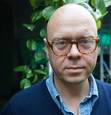Carl Abrahamsson's Blog, page 14
January 11, 2024
I’m on the Magister Dixit podcast
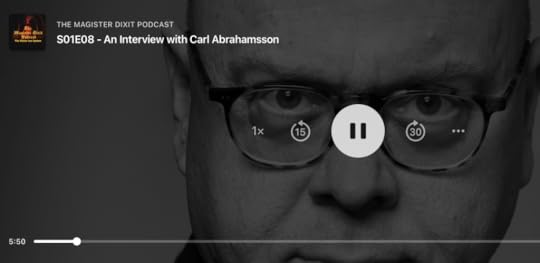
I’m on the Magister Dixit Podcast – A GREAT conversation!
https://magisterdixitpodcast.substack.com/p/s01e08-an-interview-with-carl-abrahamsson
”Our guest is none other than Carl Abrahamsson, a visionary force hailing from Stockholm, Sweden. With a career spanning across decades, Carl has blended his passions for filmmaking and the esoteric, creating a tapestry of films that delve into the mysterious and the magical. From the thought-provoking “Into the Devil’s Den,” exploring the legacy of Anton LaVey, to the intimate “Cinemagician – Conversations with Kenneth Anger,” capturing the essence of the iconic filmmaker, Carl’s lens has shaped narratives that transcend the ordinary and delve into the extraordinary. His collaboration with the legendary Genesis P-Orridge has birthed intriguing works, including the documentary “Write Your Own Code,” a fascinating exploration into the intertwining realms of spoken word and visual art. But Carl is not only a maestro behind the camera; he’s also a prolific writer. His books, a reflection of a mind steeped in the esoteric and the avant-garde, have added layers to the ongoing conversation at the intersection of art, mysticism, and the human experience.”
#magisterdixitpodcast #antonlavey #genesisporridge #kennethanger #carlabrahamsson
December 31, 2023
A great year for wifey!

Hats off to my lovely wife for having had such a productive year 2023!
She made eight new albums together with British master musician Pete Murphy, and they are all so, so good. Adding to the seven classic albums they already had together! Vanessa’s cut-ups fit really well together with Pete’s extremely versatile musical mind, and the results are simply staggering, sublime, sexy, and psychedelically seductive. You can listen to them all here:
https://petemurphy.bandcamp.com
(Or on any other streaming platform you’re comfortable with.)
She also created 52 (!) episodes of her magnificent Rendering Unconscious podcast this year. That’s right – that’s on average one episode a week. More information here:
http://www.renderingunconscious.org
So far she’s created 275 podcast episodes in total about the state of international psychoanalysis, psychology, and also art & the occult. I’m in a few of these episodes, and they are of course the best; but do listen to all of this wealth of diverse intelligence… 275 episodes so far… That’s quite a feat!
She also had two books published this year:
“Psychoanalytic Perspectives on the Films of Ingmar Bergman: From Freud to Lacan and Beyond” (Routledge), which is an exciting anthology. You can check it out here:
Then there was our joint effort: the second volume of the Magic Monday series: ”We May Need To Call On Our Cosmic Friends.” It’s made up of our weekly Patreon Posts called ”Magic Monday,” and you can find out more information here:
https://www.patreon.com/vanessa23carl
The book itself can be ordered here:
If you want the special edition, for which Vanessa made a unique art print, please go here:
And while you’re at it, please check out her Trapart Author page:
Vanessa Sinclair
She also contributed the piece “The Alchemy of Pandrogeny: Synthesis Incarnate” to Sean Woodward’s (ed.) great Tumzantorum, vol 5. (Zos House).
And of course there was more stuff happening too, not least all the events we hosted c/o Morbid Anatomy online – including the class we did in four sessions about cut-ups and magic.
To find out more about Vanessa and her amazing and multifaceted creativity, please visit her website:
About
#vanessasinclair #carlabrahamsson
December 30, 2023
The Art Magic 23 book is here!
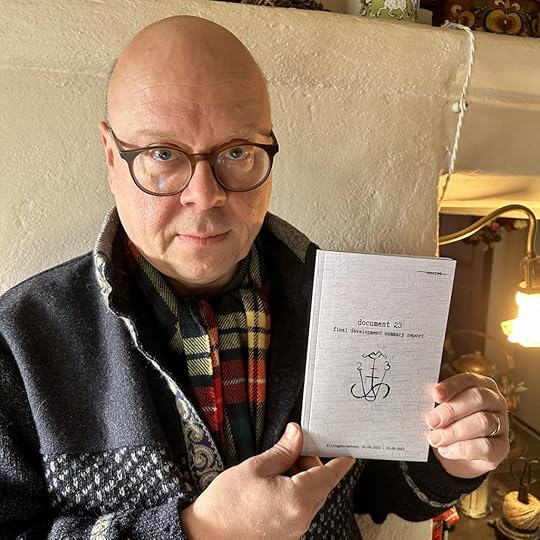
The sublime Art Magic 23 book is now published:
https://www.blurb.com/b/11842803-document-23-colour-eco
Aside from collages and photography documentation, you’ll also find an excerpt from Vanessa’s new novel ”Things Happen” and ”Whistling in the Dark: notes for an Experimental Psychodrama” by Mara Norman. You can read an expanded essay ”The Magic of Dreams Made Even More Real” by Carl Abrahamsson, and Karin Valis’ essay on ”Divine Embeddings: Sacred Alphabets and Large Language Models.” And more!
#artmagic23 #vanessasinclair #carlabrahamsson
December 28, 2023
2023: The Yearly Review of Rearview
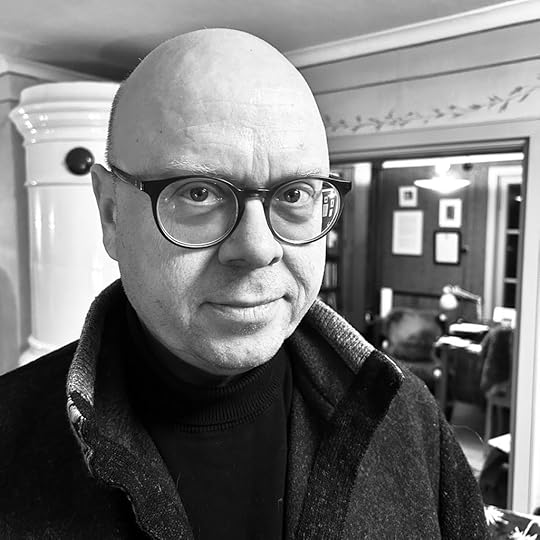
Wow! Another one… Another intense year passed by. What the hell happened? Well, let’s see…
It began in a really great way, as my book Source Magic – The Origin of Art, Science & Culture was published early on in the year. It’s a fairly logical follow-up book to both Reasonances (2014) and Occulture (2018) as it’s an anthology of essays and lectures; and, I should add, to 2024’s similar book In-between the Lines. The book was well received, and I was on so many podcasts I can definitely not recall all of them. I’m very happy that I list them as they come out! (Check’em out here.)
Vanessa and I were both published in Tumzantorum no 3, and that made me happy. Rumor has it I’ll be in the forthcoming issue, too, with an essay on talismania.
After that followed a monograph that also made me really happy: Chimera Obscura – Selected Exhibitions 2003-2014. I love going through my old photographs in general, and in this case it was extra fun as the included images have all been exhibited around the world. Nice to see them together again, and also as a kind of joint taster of the many photo books to come.
I recorded some occulture-related video lectures and put them up on Vimeo, as usual. But Vimeo has made less and less sense to me as it costs a pretty penny to be there, and my films make basically no money. So up to YouTube they went instead, and bye-bye Vimeo. I made a special page on YouTube for substantial things like talks and lectures so they will be easy to find.
My book of aphorisms and pensées in Swedish, Dagfjärilar, was published in the spring, and it also made me happy.
A musical onslaught began anew this year, with the beautiful CD release of White Stains’ Singleminded Dualisms. It’s the first of many records to be released by the great Polish label Zoharum. Digitally/Online all new releases will be handled by Highbrow Lowlife, and they can be found all over the Digisphere, and of course at our Bandcamp, too.
More on music: White Stains & Psychic TV’s classic album At Stockholm (1990) was re-issued digitally, as was Cotton Ferox’ debut album First Time Hurts (2002), and the follow-up (with Thee Majesty), Wordship (2004). A box set containing At Stockholm was also released by Vinyl On Demand, but in a very small edition (sold out!).
A new CF release was also released: Spiral Assembly Lines, which anthologizes singles, EPs and rare tracks. Plus a unique album called Dark Sexorcism (which is actually by both White Stains and Cotton Ferox), and… a re-issue of CF’s classic A Mega Golem Official album (2011).
Vanessa and I pulled off one more volume of Magic Monday posts (no 2 to be exact) and decided to call it We May Need to Call on Our Cosmic Friends (Magic Monday 2). So much magic in one and the same book! The Magic Monday posting proceeds every Monday on our Patreon. Business as usual, and one anthology a year is the idea… Come join us!
On that note, V and I also held a four week class c/o Morbid Anatomy on cut-ups and magic, and it was a whole lot of fun. My essays used in this context will be published in my forthcoming book, In-between the Lines (2024).
My photo book Temporarily Eternal – Photographs of Genesis P-Orridge 1986-2018 was issued in a hardbound edition, and it looks and feels great in every way.
Towards the end of the year, I started posting more fiction and pensées at my web site, and that will continue. As you receive this newsletter you are very likely subscribed via my web site. Thank You! But please also let your friends and foes know what a great hub for amazing things it is, and that they get a monthly newsletter automatically if they sign up at the site.
Speaking of sites, I also updated the Trapart web site. Now it feels fresh and fun again, and I have added many new authors and books to the Trapart catalog this year. Don’t miss out!
Writing-wise, I wrapped up my magical autobiography in the spring. It will be published in October 2024 as Meetings with Remarkable Magicians – Life in the Occult Underground. It has been an exciting process to write this book, and I look forward to having it out there for others to read and be inspired by.
On an end note, I’m not going to comment on the state of the world. Suffice to say that what seem to be irrevocable end times can hopefully at least be filled by some degree of intelligence and magic concocted by a few enlightened people. I hope to remain one of them, and hope that you will, too. Maybe we can leave some good stuff behind for those who will eventually carry on?
That said, I wish you a really Happy New Year!
Carl Abrahamsson, Vimmerby, December 28th, 2023
P.S. Of course there was some pretty noteworthy culture around. We saw many a film and read many a book! I listed some faves in a separate post here recently that might whet your appetites.
P.P.S. Photo by Vanessa. (As I write this, it is actually our seventh anniversary. Congrats & even more love to us!)
December 20, 2023
Scott Cummings’ new film at Sundance
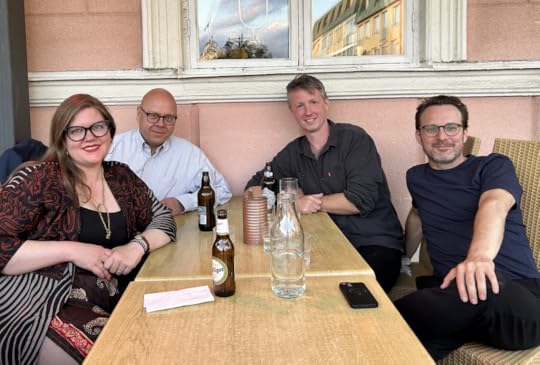
Getting ready for Sundance in January? Don’t miss Scott Cummings’ new film REALM OF SATAN:
https://festival.sundance.org/program/film/656a08effac9f4692bc048d2
I like Scott’s work a lot, and it was a pleasure to have him and great cinematographer Gerald Kerkletz visit us in the summer. Now the film is done, and will have its first screenings at Sundance in January. Congratulations, Scott & co!

#scottcummings #realmofsatan #sundance #churchofsatan #independentcinema
December 19, 2023
Book Reviews 2023 (and more)
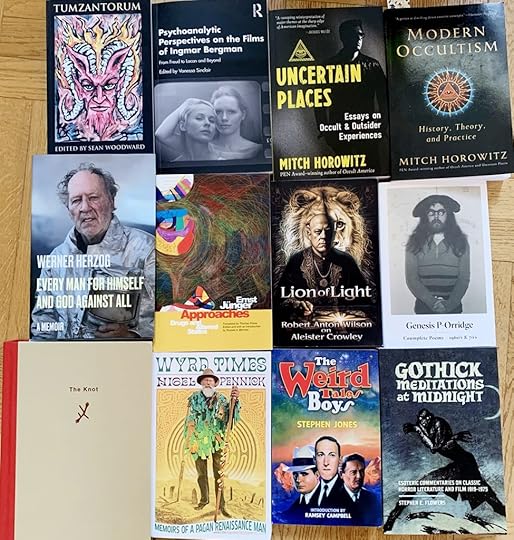
As has been stated on many occasions in these end-times, human beings no longer are ”who they are” or ”what they do,” but rather what they consume. Well then, if this is so, then this was/is me 2023:
The Weird Tales Boys, by Stephen Jones
This is a great introduction to a very important phenomenon: the pulp magazine Weird Tales and its three most celebrated authors: HP Lovecraft, Clark Ashton Smith, and Robert E Howard. Basically, without these influential authors, Weird Tales wouldn’t have had the impact it has for so many generations of science fiction, fantasy, and horror fans. A hardcore cultural impact zone. Pulp fiction of the WT kind has shaped our western culture to a greater extent than most people care to admit. Not least in the arena of science fiction and its lesser offspring: science proper. How many crazy scientists have grown up with the pulps as inspirations and instigations (even though most of these stories ended in havoc and disaster!)? Almost whatever we like in contemporary weirdness comes via the creative imagination of only a small handful of people. One distinct legacy, for instance, being Clark Ashton Smith to Ray Bradbury to Stephen King. And that’s really only the tip of the iceberg within literature specifically! This enthusiastic book traces the Weird Tales trio’s interrelationships, and the Weird Tales phenomenon as such. A great and important addition to the history of fine literature.
Gothick Meditations at Midnight by Stephen E Flowers
An absolutely excellent book for anyone interested in horror culture. The author grew up during the 1960s and was thus exposed not only to a thriving cinema culture in Texas but also TV reruns of classic monster films and what not. In this fascinating volume he provides (and I quote the cover subtitle) ”Esoteric Commentaries on Classic Literature and Film 1919-1975.” Being a magician of renown and stature, and obviously a dedicated horror aficionado, Flowers roams through his memory as well as the annals of pulp and cathode rays. It’s a very entertaining and informative read, and one that will hopefully increase the sales of small DVD labels and presses specializing in offbeat masterpieces.
The Outer Limits
Wrapping up my autobiography Meetings With Remarkable Magicians early in the year made me realize how haunted I’ve been throughout the decades by this phenomenal American TV series (1963-1965). It’s a perfect mix of Science Fiction, Horror, Psychology, and Comic Book sensibilities. We revisited it this year after realizing that Joseph Stephano wrote ”Psycho” for Hitchcock, and then rather moved on to creating ”The Outer Limits” instead of staying on with Hitch. A commendable feat, as the series is like a cosmic Mount Rushmore of intelligent TV/movies, and Hitchcock definitely dwindled after Stephano left.
Survivors
This is a great British TV-series that was aired between 1975 and 1977. I distinctly remember watching it on Swedish TV as a kid, and being mesmerized by beat up Land Rovers driving in the British mud, connecting small tribes of people huddling and trying to rebuild societies after a massive pandemic has wiped out almost all of humanity. Very dark and depressing stuff – and how prescient & prophetic fictional dystopias tend to become eventually! There’s no streaming TV series pizzazz or special effects here whatsoever; just bleak 1970s British TV drama in rolling hills, mud, Land Rovers, rifles, deceit, self deceit, violence, and… a few Survivors.
Every Man For Himself An God Against All, by Werner Herzog
The great sui generis artist/filmmaker writes his memoir and of course it’s a must read. Herzog’s life story is unlikely, his work voluminous (to say the least), and his impact colossal. This book cannot and doesn’t cover everything I would like to read about, but it’s a highly entertaining insight into a human being who can deservedly be called an Übermensch. As disappointed as I was by his 2021 novel The Twilight World (boring, flat, misdirected), as overjoyed have I been delving into this autobiography. Perhaps that’s the key to his essence: he needs to be personally involved for it to be interesting? Compare ”Aguirre – the Wrath of God” or ”Fitzcarraldo” or many of his best documentaries with flat hack films like ”Bad Lieutenant – Port of Call.” When Herzog is present and passionately engaged, there’s no one like him. This great memoir shows these unique perspectives and attitudes, and all I can say (in awe) is ”Wow!”
The Book of Chuang Tzu
On my desk lies a tiny, bruised copy of the Tao Teh Ching that I bought in Kathmandu in 1999 and have brought with me on many trips around the world. Lao Tse’s book is of course a classic, but so is the work of Chuang Tzu. Re-reading him has brought out the best in my magical perception of life and its endless possibilities. The very best thing about having devoted my life to learning (about) magic, was coming across Taoism and then being extremely happy unlearning everything I ever thought was important.
Approaches – Drugs and Altered States, by Ernst Jünger
Jünger’s presence on the English-speaking markets is increasing, and that’s a great thing. He was a very special thinker and author, and one who has inspired me in many ways. Not least because of his honesty regarding the benefits (necessity, even) of organically or chemically induced transcendences. That aspect is clearly present in this volume, which collects his writings on altered states and his own experiences with them. It really is a key work in that it shines a light on much else he has written about. The transcendental and the natural world illuminate all other aspects of (his) life, basically. Yes, he was a philosopher, and yes, he was a decorated soldier. But mainly he was an author driven by a genuine curiosity to see what’s hiding behind the next corner of one’s mind, and placing that in a greater natural context – not unlike other German giants like Goethe and Novalis. This is a highly recommended book.
Lion of Light – Robert Anton Wilson on Aleister Crowley
This is a great book if you’re into RAW and/or Crowley. It’s centered on a previously unpublished essay by Wilson that lay dormant in the Harvard archives for decades. The essay, ”Do what thou wilt,” ambitiously presents Crowley in an initiated and benevolent light, as well as Thelema as a philosophy. But there’s also his introduction to Regardie’s Crowley-bio, The Eye In the Triangle, and the intro for the Crowley anthology A Portable Darkness, and some reviews of other Crowley material. Thus the book becomes more than just one revived essay; it really gives a clear mosaic of Wilson’s approaches to Crowley and Thelema. I found it to be enlightening; it even made me want to read some Crowley again.
Wyrd Times – Memoirs of a Pagan Renaissance Man, by Nigel Pennick
A great and fun book by British magician (and a whole lot of other things) Nigel Pennick. His vast authorship spans his ditto mind and interests: magic, paganism, traditionalism, masks, runes, witchcraft etc. I love reading about people who have devoted their lives to the mysteries; there is a courage and intelligence here that most people unfortunately lack. By reaching out and over the decades this book also works wonderfully well as a general cultural history; specifically dealing with British counterculture and all its spiritual offshoots.
Coumplete Poems 1960’s & 70’s, by Genesis P-Orridge
Genesis P-Orridge was a magician first and foremost, and poetry was always his main expression. Many a different epithet has been branded upon him throughout the decades (many by himself, too) but the fundamental poetry was and is always there. That’s why it’s delightful and interesting to look through this fine little volume of collected poems. This is early stuff, predating the public shenanigans of COUM, TG and PTV etc. They give a unique insight into what was there already early on, and what was about to come: very formative expressions. In ”Obsession,” for instance, we can read ”Within the dank cave/The Dissident Watchers/Mark their cards/To cast into the eternal/Flames of chance.” Hearing that in Gen’s voice to me evokes the two first albums of Psychic TV, or even our collaboration ”At Stockholm” (1990). It is interesting that his voice is so present in not only the formulations proper but also in what the reading brings forth in the reader. Of course, that may not be true for someone who has never heard Gen’s voice, but for me it’s almost eerie. Reading is seeing, reading is hearing, reading is being there. Evocations from youth, and from beyond the grave. A sweet little book!
The Knot, by Michael Gira
Heavy! It’s a heavy book! ”Complete Words for Music, Collected Stories and Journals.” That’s something. Michael Gira is basically a writing man, and always has been. The work with the band Swans has integrated a lot of this writing into compositions and performances. But as we can see here, basically whatever Gira writes also works as standalone, undefinable, undeniable, and free expressions from a very creative human being. ”Lyrics,” short stories, journal entries (that also contain strong fictional elements), and thoughts… For anyone enjoying Swans, this anthology becomes like a bible of sorts: a deep introspective insight into a life, and into the forces pushing that life onwards to an almost pathological process of creation. I confess to loving Michael Gira and his relentlessly soul-searching work. What an amazing artist he is. This book for me is therefore valuable and highly cherished.
Modern Occultism + Uncertain Places – Essays on Occult & Outsider Experiences, by Mitch Horowitz
American author Mitch Horowitz is a key player in the general occulturation of the civilized world. His diligent authorship of essays, lectures, and books proper, as well as editing many a book on causative thinking, has generated a status of authority well deserved. You can always find out new and interesting things when reading Horowitz’s work; mainly because he is a great writer and more open-minded than academics: a very important combination in this day and age.
This is how I blurbed his latest book Modern Occultism: ”In many ways, Horowitz is the perfect mix of Manly P. Hall, Joseph Campbell, and Prometheus, eloquently carrying the torch of mythic and spiritual illumination into the 21st century.”
Uncertain Places is an anthology of Mitch’s great occulturation essays: pieces of intelligence and scholarship that contextualize esoteric history and places its development and fragmentation/dissemination in our modern world.
Both these books are like a crash course in heavy duty knowledge that many of us need to fully understand how things literally move from the hidden spheres of history and culture and right into the mainstream. A highly relevant, revelatory, and important topic.
Check out Modern Occultism here.
Check out Uncertain Places here.
Tumzantorum, edited and published by Sean Woodward
A very interesting occultural journal that always contains fresh perspectives on all things magical. Vanessa and I were featured in issue number 3, but I would recommend checking them all out. Masterminded by highly talented artist-magician Sean Woodward, Tumzantorum always provides great food for thought.
Psychoanalytic Perspectives on the Films of Ingmar Bergman, edited by Vanessa Sinclair
My lovely wife edited this anthology of psychological texts about the work of Ingmar Bergman, and invited me, too. Marital nepotism is a delight – as well as great for this book. I wrote an essay on Bergman’s masterpiece ”Hour of the Wolf” (1968) and am very pleased with it. My quite distinctly Jungian goggles make for a good balance within a cluster of Freudian and Lacanian perspectives that sometimes trip themselves skidding on a thin ice of intellectual (b)anality. But that’s also the genius of Bergman: like all genuine artists, he provokes different things in different people, and that’s exactly how it should be. Hopefully this book will encourage people to watch the films, so that everyone can have an opinion of their own.
December 15, 2023
The Circle of Harmony & Friendship

Some time in the not so distant future, right after all the optimists had gone into space and all the pessimists lay buried in the earth, a high-flying bird swooped down and caught a careless worm sticking up its body over ground. A tasty morsel for those on the go!
A dog watched this, thinking, ”Oh, that bird would sure be nice to chomp on.” But as the dog couldn’t fly the bird was safe; deep inside one’s own element there is always more good luck. The dog walked away, sniffing something new on the ground. Wait… Something smells really interesting over there… What could it be?
A cat was ecstatic about having caught the bird while it was cleaning its beak in a little puddle. The cat, hiding in a bush, jumped out, and pawed the bird to the ground; jamming its tiny teeth where it hurt the most. Paralyzed yet flapping, the bird tried to scream out its agony but to no avail. Its last sensual impression was seeing the cat’s bloody face and then…
The dog jumped the cat (and the bird) and pawed it to the ground; jamming its large teeth where it hurt the most. Fighting back was hard because the dog was big and its teeth and claws ripped and tore and then suddenly the cat couldn’t feel anything anymore. The last thing the cat saw was a human being approaching the scene…
”Good dog! That’s a good dog!” Although busy with its feasting, the dog found it best to cuddle up just a moment with this human man being that it had never seen before. Because if it didn’t, the human would beat it to a pulp and eat it, as well as the cat, and the bird, and the worm. No good. Let the human pet me, it thought, and then I can get back to my food.
The human sat down and watched the dog eat. He took out a can from his backpack, opened it, and ate the contents with his fingers. After they had both eaten enough, the human got up. He pulled down his pants, squatted and defecated on the ground. The dog was enthusiastically prancing about, yapping affectionately. As soon as the human had pulled up his pants and taken few steps back, the dog rushed for the warm pile of shit and ate it all up. ”That’s a good dog… You enjoy that, buddy!”
Together they walked onwards looking for other survivors and more food, occasionally stopping and petting each other.
The human realized one thing: ”This bitch is far superior to me. I’ll see what she can find, and if push comes to shove I will kill her and eat her.” The dog presented the human with its most adorable sad face, thinking, ”That asshole is far superior to me. I’ll see what he can find, and if push comes to shove I will kill him and eat him.”
They walked onwards casually towards the sunset horizon. Their vibrations on the ground attracted a gang of worms and other bugs eating a human corpse just below the surface. Little did they know another cat was watching their wriggly bodies emerging in the rain-soaked mud.
It just had to wait until the human and the dog was far enough away.
White Stains & Psychic TV, boxed
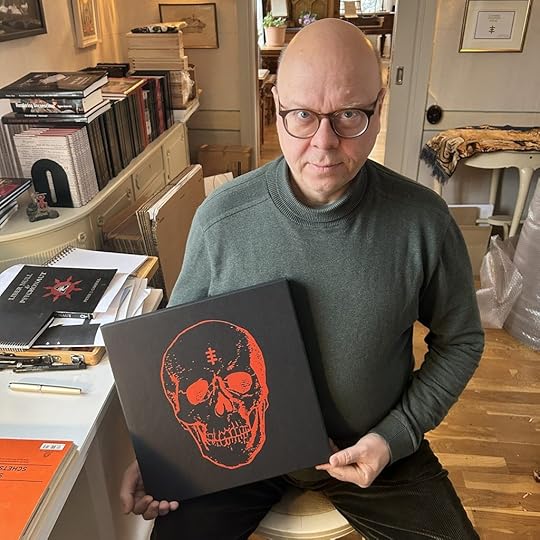
I just got this lovely box from Vinyl On Demand: The White Stains & Psychic TV album AT STOCKHOLM on double vinyl + two extra LPs with rare PTV stuff, and a T-shirt. AMAZING stuff! Limited to 88 copies!
It is probably already sold out but … Never give up hope!
Thank you Frank & VOD for such amazing work over the decades!!
#vinylondemand #psychictv #whitestains #atstockholm #genesisporridge #thomastibert #carlabrahamsson
December 8, 2023
Carl Jung: Mythmaker
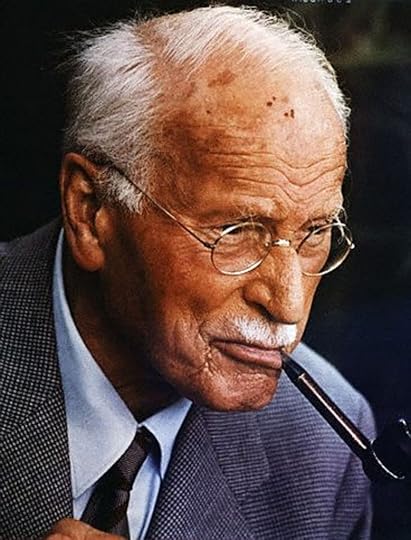
On the whole, Carl Jung is already so well documented and well known that it’s almost not worth talking about him. Jung is a superstar of a different kind than Freud, despite the fact that they have both been important pioneers within psychology as we know it. The word pioneer isn’t even enough to describe them. They are both rather founders of modern psychology, which has now, in its rebellious teen independent phase, tossed them both out. Jung packed a stronger punch but not because he was less esoteric and incomprehensible than Freud – in many ways he was more so – but because he was taken in and integrated in the surrounding culture much faster.
Even early on Jung was part of culture. The Dada movement shared the same environment as the budding psychology movement in Switzerland. Herman Hesse was his patient, he visited the Monte Verita commune at Ascona, and he had a creativity of his own that he battled with. Jung also interpreted cultural phenomena in more general ways than Freud, whose focus was usually on the individual and on isolated experiences. Jung focused considerably more on the integration and analysis of myths, religions, customs and symbols.
In the development of concepts like the “archetypes” and the “collective unconscious”, Jung not only looked at isolated myths in themselves but also at their artistic expressions. He claimed that there is an impulse-generating layer in the psyche that is shared by all human beings and that can be directly accessed through introspection, dreams, the study of myths and personal, artistic work. A certain culture can possess a more rational or “civilised” construction than another but the basic psychological foundations are in essence the same globally. Jung’s travels around the world and his collection of data confirmed his theories and became an important part of his system.
The general openness that followed after the second world war – decidedly a necessary pendulum movement – was integrated in both Jung’s life and work in an enormous amount of material telling the story of what had so far gone wrong. The individual’s need to find him/herself, a healthy individualism in a paranoid and collectivistic world, attractive myths with strong emotional resonances, many possibilities of interpretation, the integration of one’s own artistic process and many other aspects eventually contributed to both a liberalisation of western culture in, for instance, the hippie movement, and later in what we today call the new age movement. And perhaps even to a stronger presence of political liberalism.
One can feel and think what one wants about all of these manifestations but no one can deny the influence that Carl Jung has had on our culture. It’s been there hand in hand with an overall need to find new ways that are not dictated from above or even from the outside but that must be discovered by each and everyone on the inside, in the spiritual and the occulted.
When things are broadened, popularised and integrated in a culture, the precursors, pioneers, codifiers and formulators are often lost along the way. Generalisation becomes the norm and old terms are used in new contexts in pragmatically simplified ways. What once originated in advanced psychological reasoning in an open-minded yet empirical method becomes vague sloganeering and transparent virtues to make necessities of.
A pop cultural book by Jung like Man and His Symbols is filled with highly relevant material to a deeper understanding of Homo Sapiens as a cultural being. But the main attraction lies in its accessibility and the opportunity to quickly get an attractive overview in an increasingly complex, confused and fragmented world. One jumps over the conclusions and preferably also demands of critical thinking to instead find an alluring and irrational solution to personal issues through a very general kind of inspiration. Where Jung claimed that many of our central myths told stories about essential things that each individual must process in a hard and quite often painful process of individuation, the modern interpretation, say from the 1960s and onwards, has become one of facing the path of least resistance and adapting to its attractive shortcuts. Where Jung wanted to make us aware of what is already there, inside us, most people still keep looking for outside sources.
“I have called this wholeness that transcends consciousness the ‘self’. The goal of the individuation process is the synthesis of the self. From another point of view the term ‘entelechy’ might be preferable to ‘synthesis’. There is an empirical reason why ‘entelechy’ is, in certain conditions, more fitting: the symbols of wholeness frequently occur at the beginning of the individuation process, indeed they can often be observed in the first dreams of early infancy. This observation says much for the a priori existence of potential wholeness, and on this account the idea of entelechy instantly recommends itself. But insofar as the individuation process occurs, empirically speaking, as a synthesis, it looks, paradoxically enough, as if something already existent were being put together.” [1]
One could definitely say that Jung is the contemporary norm in these spheres. His terminology rules; if not within clinical psychology, then definitely within popular culture with terms like introvert, extrovert, synchronicity, anima, animus, etc.
Jung’s integration of myths as an expression of fundamental psychological truths got a push forwards through American mythologist Joseph Campbell’s successful books, like The Masks of God, The Hero of a Thousand Faces and The Power of Myth. Here we also find an accessible focus on the analysis of myths, mainly filtered through religion, fiction and popular culture throughout the millennia. Although social contexts constitute much of our lives, Jung and Campbell, as well as many other later Jungians, always stressed that development is an individual affair; that it could be no other way:
“It has been one of the really painful problems of the modern Western individual to gain release for his conscience from this Levantine assurance of a separation of spirit and nature (mythic dissociation), together with its correlative totalitarian dogma (social identification) of ‘society’ – almost any quorum, it seems, will do: a ‘people’, a ‘Church’, even a trade union, or anything calling itself ‘the state’ – as the only vehicle of value, through association with which an individual can achieve worth: when actually the truth is the other way around, that whatever human worth a social group may claim, it will have gained only by grace of the great and little individuals of its membership.” [2]
In the 1960s, even structuralist philosophers like Roland Barthes began writing about contemporary times from a mythological perspective. He shows that phenomena like Greta Garbo, Einstein’s brain and even striptease must be interpreted in a mythological way. Like Jung, Barthes claimed that myth is essentially a language. Where Jung wrote that this language in itself also constituted an essential content for personal development, for Barthes the mythological language became more of a convenient tool for his own contemporary criticism.
But the very term “mythology” was brought forth again and no longer strictly within academic fields like the history of religions or anthropology. From a psychological perspective one could say the concept of myth was made conscious by Jung and his later interpreters. Suddenly it was around in a wider and more public context.
With this, the terms myth and mythology gained more meanings. Where it used to signify a group of behaviours and stories that had lived on orally or written down and that could be focused on, today it’s become diluted and can signify anything from a lie to a feeling: “No, that’s not correct, it’s just a myth”, or “That felt totally mythical.” This dilution is of course a part of contemporary western culture in general. One could almost say that our contemporary mythologies to a large extent consist of upheavals. Not just of old kinds of tradition but also of how we experience them, how we value them. Perception certainly hasn’t been sharpened (which some technophiles like to argue) but rather dulled, and the material we experience consists of impoverished and diluted versions of what once transmitted something substantial.
An example: Our western dramaturgy is based on what’s usually called a Homeric structure. It ties in to Homer’s stories about Odysseus’ travels towards distinct goals. During his travels Odysseus faces problems and challenges that he, either alone or together with others, deals with and solves. This is a very simple set-up and yet seemingly endlessly fascinating. The same story has been told in so many ways and in so many different media that it’s mind-boggling when you think about it. The reason for this is very likely the actual weight of tradition. You tell your kids the same story that you were once told yourself. These stories are more important than most parents seem to understand.
But what’s happened since the days of Jung are mainly two things: technology driven mass media is one thing, and the commercialisation of shared, public space another. Both these things have contributed to that the amount of fiction has increased in relation to one’s own thinking. Where previously we chose fiction in a compartmentalised manner and actively took part of it, today we are overrun by TV, the Internet, movies and commercials of all kinds, and this mainly happens passively. I have stated before (and I’ll do it again) that we now live in and through more fiction than so called fact-based reality. Fiction has taken over. If we want to break it down one more level, we can say that our own mythologies need our voluntary submission to too much, too many and that too quickly. That’s when we leave the original function of myth: education, teaching and explaining things that are conducive to one’s own mental health, in unfortunate favour of being driven into a wall of technological rule and perceptional deficiencies at an exponentially increasing speed.
How would Jung interpret our contemporary times? I can of course only speculate – and I gladly do. I believe he would have called it reversion. Where he claimed that the answers lie within ourselves on individual but also culturally integrated levels, and that one needs to work hard to reach these deeper levels, basically everything today is reversed or contrary: attractive tsunamis of empty promises in commodified and disposable identities together with fictions filled with immediate and evanescent saturation. And, to add insult to injury, told in narrative structures that “retardifies” the partaker: we see what happens, then at least two participants retell what just happened as if we can’t get it ourselves. It’s a breaking down of the barriers of human intelligence and dignity.
The result is a kind of anti-Jungian abyss. Stress and existential anxiety increases but is not treated therapeutically but pharmaceutically. The human being is allowed to believe in whatever she so desires but doesn’t really believe in anything at all. And those who actually do believe in something seem willing to kill all those who don’t share their specific belief.
If you simply exchange a cluster of well-tried and well-meaning myths for arbitrarily created (and often quite non-altruistic) pseudo-myths, then perhaps we simply can’t handle it? The contact with the deeper layers of the psyche may actually be literally essential for the individual. That’s what Jung claimed anyway. No outside structures can act as substantial substitutes for the gnostic and direct contact the individual needs in his/her development. One parallel example could be the fact that we can’t survive if we can’t or aren’t allowed to dream.
One important part of functional myths is relevance. The reason why certain stories still live on is that they’ve transmitted definitive and engaging knowledge and wisdom. What is relevant today? And how should we preserve that in such a fragmented existence as ours? Very likely we’re looking at oral transmission, possibly amplified by physical books. All the so called digital storage media are highly ephemeral gadgets, and we all know it. They won’t last. And what will actually be told? What’s going to be relevant for those who come next?
Desperate attempts at contact with our own (hi)story and a permeating anxiety about the future is what’s defining a lot of our contemporary history writing. I recently re-watched the first Planet of the Apes films and they are like a contemporary mythological gold-mine, despite the fact that they are already 40-45 years old. At first, some humans led by Charlton Heston land on a planet that reveals itself as earth in the future. The planet is now run by intelligent, talking apes who keep the remaining human population as slaves. This is a simple science-fiction and mythological presentation: you travel in time to show a nightmare scenario. But the interesting thing about Planet of the Apes is that the story goes on. The reason for the power switch between apes and humans in the future is that some of the more benevolent apes in Heston’s company actually go back in time on earth – intelligent and talkative – to an existence of being caught and maltreated because they stir up a riot among the lower kinds of apes. However, their genetic offspring develops, takes charge and eventually enslaves the humans. That is, until Charlton Heston shows up several thousands of years later. It’s a very simple yet efficient time warp/potential loop scenario in which we are exposed to the problems of xenophobia, anthropocentrism, vanity and the worship of technology in fairytale form. A beautiful and substantial myth. Similar examples exist in Lord of the Rings, which very much contains Tolkien’s filtering of medieval European myths spiced with plenty of xenophobia.
Jung’s friend and colleague, the Rumanian historian of religions Mircea Eliade, basically shared and amplified his views: “An object or an act becomes real only insofar as it imitates or repeats an archetype. Thus, reality is acquired solely through repetition or participation; everything which lacks an exemplary model is ‘meaningless’, i.e. it lacks reality.” [3] The Archetype is, as we know, a strictly Jungian term and concept. Archetypes are the forces or symbols that individuals can meet in the inner, in dreams, visions and in daydreams and that clearly reflect, if symbolically, variants of current existential issues. This leads to the question: Do Eliade and Jung mean that those who haven’t yet acknowledged the archetypes lack a sense of reality, or that they themselves are unreal? It’s a highly relevant question for us today. If we are actively opposed by flamboyant superficiality and Angst-ridden identity crises then we can at most reflect each other; thin surfaces that reflect other thin surfaces. When this is passed on to new generations the result is an increasingly accentuated weakness.
Eliade also claimed that basically all relevant myths retell the original story of creation, regardless of which culture that tells it. There is a need to be reborn and one does that by acting out ritualised creations, or “active symbols” as Jung would call them. This is also interesting from our contemporary perspective: exactly which story of creation is permeating our culture and individual interpretations? Although it’s tempting to answer “none”, I think it’s more interesting to look at one main current theme: active dissociation from the earth. In fiction, the threat has always come “from beyond” (the bend, outer space, another country, etc). We create and recreate here, in our own little paradise. But as the threats of real life increase (terrorism, pathogeny, asteroids, etc) and thereby disturb the smooth recreation stories in/of paradise, the current expressions (mythic or simply escapist) also reflect that increase. Hence we are flooded with stories of space dystopias (us going out, “them” coming in), supernatural creatures disrupting death (zombies, vampires et al), urban malaise, sexual confusion, more and more superheroes, etc. Entertainment not only reflects but also actively leads the way. Acclimatisation to inner voices and spiritual helpers is regarded as a facet of insanity, while Pokemon Go takes on like wildfire.
We are permeated by an illusion of empowerment. One example could be the first The Hobbit film. It’s a distant part of a genuinely interesting work based on mythology: Tolkien’s books. The first trilogy of film adaptations found a strong resonance with the Zeitgeist and became an immense success. But in the first Hobbit film there are scenes that are distinctly as plucked from another medium – that of the computer game. The dramaturgy, aesthetics and experience transcends the story in itself to create a comfort zone in an abstracted tool or, as it’s called today, a platform. Storytelling without a real story. Is there any difference between that film scene where Legolas is jumping up and down on moving blocks and the one in the computer game? The difference is one of illusory empowerment: you can “be” the character in question in the game. It’s like when children play: “I’ll be this one and you’ll be that one.” The difference being that it’s still a passive existence inside the computer game, without any connection to active imagination, day dreaming, associative fantasy etc. It’s not a therapeutic process but rather just a dulling one. Hence it’s not a myth but just mere escapism.
So how can we awaken the power of mythology if we believe, like Jung did, that it’s beneficial for health and existence? Well, the mere study of myths is fascinating and rewarding. Jung can be hard to read at times but there’s no escaping that Man and His Symbols is a great introduction. Joseph Campbell too. Campbell created pop culture out of subjects previously reserved for academic specialists. In reading Jung, Campbell and even Eliade we understand the weight and importance of mythology. Which opens us up to looking at the world with new and wider eyes, and makes us connect even the smallest things with larger meanings. The fairy tale is the child’s first contact with an abstracted world beyond the immediate family, and thereby a strong contribution to how one deals with one’s own life later on. If, instead, you press an iPad or a cell phone with a blinking, buzzing game in the hands of a child to silence the him/her, how will that turn out?
For Jung himself, being an ardent empirical scientist, it was difficult to open up to the inner visions he experienced early on in life. At times, he even discarded them as “psychotic incidents”. But gradually he trusted his own intuition and began work on the book that may be his most important: the “red” book or Liber Novus. It was simply a book he wrote and illustrated for himself and which grew and grew with time. It contains religious writings, visions and symbolic images all stemming from his own depths. We can’t really say that Jung was a traditional Christian but he was most definitely a Gnostic. Many of his texts are Gnostic, in the sense influenced by early Christian writing; claiming that it was perfectly possible to maintain a direct contact with God without proxies like priests or churches. Jung didn’t want Liber Novus to be published or even shown during his own lifetime, but when it eventually was, in 2009, it became obvious that the work on the book had been extremely influential for many of his thoughts and theories. And that he was actually a very talented visual artist too. It was during the work on this book that Jung developed his ideas on the collective unconscious, the sphere that he claimed all specimen of Homo Sapiens share, like a general DNA of the soul, and to which you can return to access both information and inspiration in life.
“By far the most fruitful attempts, however, to find suitable symbolic expressions for the self were made by the Gnostics. Most of them – Valentinus and Basilides, for instance – were in reality theologians who, unlike the more orthodox ones, allowed themselves to be influenced in large measure by inner experience. They are therefore, like the alchemists, a veritable mine of information concerning all those natural symbols arising out of the repercussions of the Christian message. At the same time, their ideas compensate the asymmetry of God postulated by the doctrine of the privatio boni, exactly like those well-known modern tendencies of the unconscious to produce symbols of totality for bridging the gap between the conscious and the unconscious, which has widened dangerously to the point of universal disorientation”. [4]
Unfortunately, I don’t think Jung will reclaim his well deserved central status within the field of psychology. Psychology is a phenomenon, just like history writing, that is at times too affected by its own environment and contemporary influence. But I do believe that Jung’s thoughts and ideas will take on new forms and carry on within art, literature and other expressions of culture. Because we don’t really need more existential manuals or more neurochemistry, but rather intuitive incentives, in which we see the totality and our own story clearer, to be able to make our own decisions. Causal, empirical science just isn’t good enough for that, so we need fairytales, poems and dreams, as well as old and new myths, to be able to act intelligently on both individual and species levels.
Notes:
Carl Jung: “The Psychology of the Child Archetype”, in Essays on a Science of Mythology , Bollinger/Princeton, Princeton 1969, p 83-84Joseph Campbell: Creative Mythology: The Masks of God , Penguin, New York 1968, p.637.Mircea Eliade: The Myth of the Eternal Return , Princeton/Bollingen, Princeton, 2005, p 34.Carl Jung: Aion – Researches into the Phenomenology of the Self , Bollingen/Princeton, Princeton 1969, p 269.This essay was originally published in my book Occulture – The Unseen Forces that Drive Culture Forward (Inner Traditions, 2018). Please consider buying a copy of the book.
The Opposer

The Opposer
Deep within me
The voice of wonder
Of strength
Recurring
A self-image projected by others
A self-reliant loop
Feeding back insecurities
Until they fade away
What remains
Shall be hidden
What is hidden
Shall remain
Transforming itself
Into tangible shape
Related causal cacophonies
Writing between the lines
We can not change who we are
Can we not
Extrasensory memories
Encouraged
Indescribably simple words
Groundbreaking
At least for me
The Opposer

